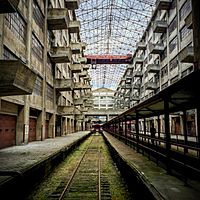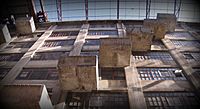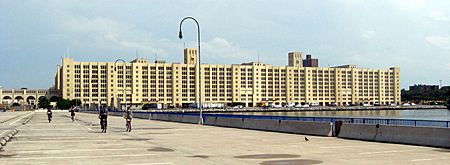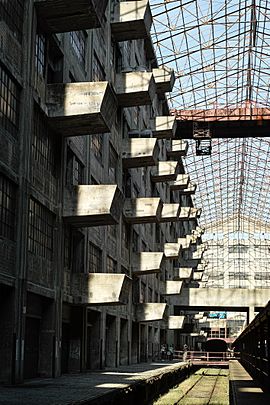Brooklyn Army Terminal facts for kids
Quick facts for kids |
|
|
U.S. Army Military Ocean Terminal
|
|
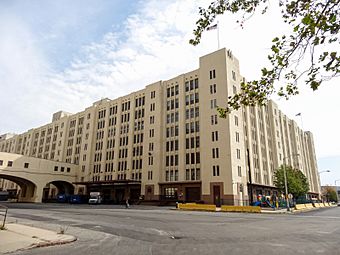
Side view
|
|
| Location | 58th–65th St. and 2nd Ave., Brooklyn, New York |
|---|---|
| Area | 97.2 acres (39.3 ha) |
| Built | 1918–19 |
| Architect | Cass Gilbert |
| Architectural style | Industrial |
| NRHP reference No. | 83001702 |
| Added to NRHP | September 23, 1983 |
The Brooklyn Army Terminal (BAT) is a huge building complex in Sunset Park, Brooklyn, New York City. It's like a giant storage and shipping center! This massive site covers over 95 acres (38 ha) right on Brooklyn's western shore.
It was first built for the United States Army during World War I. Back then, it was called the Brooklyn Army Base. Today, it's used by many different businesses and even has an NYC Ferry stop. The terminal is so important that it was added to the National Register of Historic Places in 1983.
A famous architect named Cass Gilbert designed the Brooklyn Army Terminal. It has two giant warehouses, three long piers, and many smaller office buildings. It also had special rail sidings for loading cargo onto trains. When it was built, its warehouses were some of the biggest concrete buildings in the world! The Brooklyn Army Terminal is right next to the old Bush Terminal, which the United States Navy used.
Construction for the terminal started in 1918 and finished in 1919. After World War I ended, the terminal was used for different things, like a dock and even a military holding facility. During World War II, it became the biggest military supply base in the United States. The Army stopped using it in 1967. Later, the United States Postal Service and the Navy used it for a short time. In 1981, the New York City government bought the terminal. Since then, it has been updated for businesses and light industry.
Contents
What is the Brooklyn Army Terminal like?
The Brooklyn Army Terminal covers about 97 acres (39 ha). It has two huge 8-story warehouses and three 2-story piers. There are also many smaller buildings and a train yard that could hold 2,200 train cars!
The two main warehouses are called A and B. Warehouse A is 200 by 980 feet (61 by 299 m), and Warehouse B is 306 by 980 feet (93 by 299 m). These buildings are super long, stretching between 58th and 63rd Streets. When it was finished, Warehouse B was the biggest building in the world by floor area!
Warehouse B has a large open space inside, like a giant hall. This hall has two old railroad tracks that are no longer used. You can even see two old train cars parked there! The loading areas in this hall are built in a cool, staggered way. A huge crane, weighing 5-short-ton (4.46-long-ton; 4.54-metric-ton), used to move cargo between these levels.
Three railroad tracks ran between the two warehouses. A tall 8-story office building was located north of Warehouse A. Bridges on the third floors connected the warehouses and piers. Another bridge linked the old office building to the warehouses. The complex also had a power house and other utility rooms. Each pier was 1,300 feet (400 m) long and 130 feet (40 m) wide. They were double-decked, meaning they had two levels.
The Brooklyn Army Terminal's northern side, 58th Street, separates it from the Bush Terminal. The Bush Terminal also had warehouses, but they were used by the United States Navy.
How did trains connect to the terminal?
The railroad tracks at the terminal connected to four car floats. These are like giant barges that carry train cars across the water. The tracks also linked to a big rail yard in Bay Ridge. From there, they connected to the Long Island Rail Road and then to the rest of the United States!
At its busiest, the terminal had over 13 miles (21 km) of tracks. Many tracks were removed by the 1970s. However, a direct track connection to the Bay Ridge Branch was added in 1973. Some tracks are still used today by New York New Jersey Rail to move freight along the waterfront.
Today, Buildings A and B are managed by the New York City government. They are used for light manufacturing. The old office building was turned into a food-making complex in 2017.
History of the Terminal
How was the terminal built?
The Brooklyn Army Terminal was also known as the U.S. Army Military Ocean Terminal. It was part of a bigger plan called the New York Port of Embarkation. The U.S. Congress approved its construction on May 6, 1918, during World War I.
Cass Gilbert designed the base. Construction began on May 15, 1918. The city put aside $40 million for the project. Six thousand workers from Turner Construction helped build it. The project was so big that extra subway trains were added to bring workers from Manhattan!
To save money and steel, the buildings were made from reinforced concrete. This was poured into wooden forms. The floors were designed to hold very heavy loads. The construction used a huge amount of wood, about 7 million feet! At the time, the Brooklyn Army Terminal was the world's largest concrete building complex. The government spent $32 million to build it.
Military Use of the Terminal
The Brooklyn Army Base was finished in September 1919. It could handle 1,500 short tons (1,300 long tons; 1,400 metric tons) of outgoing cargo every hour. It could also store 500,000 short tons (446,428.57 long tons; 453,592.37 t) of freight. Since World War I had ended, it wasn't used to its full capacity right away.
The base was also designed for light industrial use, so it could be used by civilians after the war. In 1920, the government started offering leases for parts of the base. The complex had 4,680,000 square feet (435,000 m2) of storage space. This could hold up to 450,000 short tons (400,000 long tons; 410,000 t) of cargo.
In 1923, the government bought land from the estate of William C. Langley for $2.4 million. This land was needed for the base. The same year, the Shipping Board started leasing piers to private companies. Large transatlantic liner ships could even dock at the terminal's piers.
An experimental living area for soldiers was opened in 1928. It could house 500 service members who were on leave or waiting for new assignments. By 1929, some people suggested that the Port Authority of New York and New Jersey should take over the piers. But the base commander said the base would not be closed or sold.
In March 1930, officials announced plans for a military holding facility at the base. It would hold up to 125 service members who had committed serious offenses. Community members were not happy about this plan because they were not asked about it first. Despite their protests, the government went ahead with the facility.
The Brooklyn Army Terminal was the biggest military supply base in the United States during World War II. It had its own railroad, police, and fire departments. News reports from that time said the base handled 43,000,000 short tons (38,392,857.14 long tons; 39,008,943.82 metric tons) of cargo. It was also the starting point for 3.5 million soldiers during the war. The terminal employed 20,000 workers and was the main office for the New York Port of Embarkation.
After the war, a safety program greatly reduced accidents at the terminal. It became one of the safest ports in the U.S. The Brooklyn Army Base also received the bodies of thousands of soldiers who died fighting in the war.
In the years after World War II, about 200,000 soldiers arrived or left the base each year. The 328th Army Band would play music every time troops came or went. In the late 1950s, the base welcomed refugees from the Hungarian Revolution of 1956. It also received victims from a ship crash in 1956.
In 1958, Private Elvis Presley sailed from the Brooklyn Army Base to Germany. He was with 1,170 other soldiers. By 1963, the terminal had 1,800 civilian workers and over 200 military staff. Another 1,600 people lived at the terminal. At that time, it received 4,500 short tons (4,000 long tons; 4,100 metric tons) of cargo every day by truck. Another 2,500 short tons (2,232.14 long tons; 2,267.96 t) arrived daily by train.
When did the military base close?
In May 1964, the United States Department of Defense said it might close the Brooklyn Army Base. This was part of a plan to save money by closing military sites that were no longer needed. Local leaders and unions tried to stop the closure.
But in November 1964, Defense Secretary Robert McNamara announced that the Brooklyn Army Terminal would be one of many bases to close. Only the military part would close. Most civilian workers would keep their jobs. By 1965, it was confirmed that the terminal would close to military use on January 1, 1967. The Army's shipping work would move to Bayonne, New Jersey.
A closing ceremony was held on December 9, 1966. The New York City government then announced it would buy the terminal. The city wanted to use it for shipping and trade. They planned to move their foreign-trade zone from Staten Island to the terminal.
After a fire at a mail facility in Manhattan in December 1967, some mail operations moved to the Brooklyn Army Terminal. The terminal started handling 18,000 bags of international mail every day. Four thousand workers were employed there. In December 1970, the government announced that the post office facility at the terminal would close.
Shipping operations at the terminal started again in 1970. The Navy moved into the terminal in 1972 and renamed it the Military Ocean Terminal. Army shipping activities fully moved to Bayonne by 1974. The U.S. military completely left the terminal by October 1975.
The city buys the terminal
In August 1979, the United States Senate voted to let the government of New York City buy the terminal. The United States House of Representatives voted the same way in November. The city then asked for ideas from developers on how to use the terminal.
The city received four proposals. Two were for industrial use, one for homes, and one for mixed use. In September 1980, Helmsley-Spear Inc. was chosen to develop an industrial site. The government and city then discussed the price. They argued for two months over how much the terminal should cost.
By December, the government agreed to sell the terminal for $8.5 million. The city would pay $4 million, and the rest would come from the U.S. Economic Development Administration. The federal grant was finally approved in April 1981.
The sale was completed in July 1981. But in September, Helmsley-Spear Inc. decided not to sublet the terminal from the city. This happened after a disagreement about the lease terms. The city found out that Harry Helmsley, a partner, was selling other buildings nearby for homes and shops. The city thought this would make the Army Terminal more valuable. So, they wanted a bigger share of the profits from renting it out.
By 1983, the city hired Eastdil Realty to help fix up the first building. Most of the $20 million needed would come from private sources. The city would give $2 million and hoped for another $5.6 million from federal grants. The city thought a full renovation would take four years and cost $36 million.
The Brooklyn Army Terminal was listed on the National Register of Historic Places in 1983. This listing included 11 important buildings on 97.2 acres (39.3 ha) of land.
What is it used for now?
The city government started fully renovating the northern half of Building B in 1985. This added 1,000,000 square feet (93,000 m2) of new space for rent. The renovations included new electricity, water, and heating systems. They also replaced elevators, added restrooms, and improved the outside of the building. The first phase created 32 industrial units. Each unit had about 30,000 square feet (2,800 m2) of space. These renovations cost about $33 million.
After the work was done, the New York City Economic Development Corporation (NYCEDC) started renting out the property. It became a place for many light manufacturing, storage, and office businesses. The first businesses signed leases in May 1987. By August 1988, 60% of the space was rented. By October 1989, all available space was rented.
In 2013, the city started offering public tours of the terminal's inside. These tours were given two weekends a month. Two years later, the city began a $100 million project to fix up 500,000 square feet (46,000 m2) in Building A. This was expensive because of cleanup work needed. The NYCEDC also started turning the old Administration Building into a food-making complex for $15 million.
By 2016, 3,700 people worked at the Brooklyn Army Terminal. The city planned to add 1,000 more jobs in the next ten years. A job center was set up to help local people get jobs at the terminal.
NYC Ferry started service to the Brooklyn Army Terminal in May 2017. The terminal's food manufacturing complex opened in June. The renovation of the 500,000-square-foot space in Building A was finished in June 2018. This was just after the 100th anniversary of when construction started.
The newly fixed-up area could hold 20 more companies. By this time, 92% of the terminal's renovation was complete. The Brooklyn Army Terminal had 100 companies employing 3,800 workers. The city expected 1,000 more jobs once all the new space was rented. Many new businesses were in technology, media, food, or manufacturing. The total cost of restoring the complex was about $300 million by 2018.
In January 2021, during the COVID-19 pandemic in New York City, a large vaccination site for COVID-19 shots opened at the Brooklyn Army Terminal. It operated 24 hours a day, 7 days a week.
How to get to the Terminal
The piers at Brooklyn Army Terminal are used by NYC Ferry's Rockaway and South Brooklyn routes. The MTA Regional Bus Operations' B11 bus route ends outside the terminal. The B37 bus route stops nearby on Third Avenue. The closest New York City Subway station is at 59th Street and Fourth Avenue. This station is served by the N and R train trains. A bike path, part of the Sunset Park Greenway, connects the terminal to Owl's Head Park to the south.
Ferry Service
A fast ferry service from Brooklyn Army Terminal to Manhattan was first suggested in 1994. It was meant to help the Sunset Park area grow. This boat service started in late 1997. It brought more business to the terminal area.
After the September 11, 2001, attacks disrupted subway service, the city started a free ferry from the terminal's 58th Street Pier to Pier 11/Wall Street. New York Water Taxi took over the route in 2003 and started charging a fare. In 2008, they added a route to Breezy Point, Queens, stopping at the terminal. This service stopped in 2010 due to lack of money.
After Hurricane Sandy in 2012, SeaStreak started a ferry route from Rockaway Park, Queens, to Pier 11. A stop at Brooklyn Army Terminal was added in August 2013. This was because the Montague Street subway tunnel was closed. The ferry was very popular! About 250 people rode it daily between the terminal and Manhattan. The route carried almost 200,000 passengers by mid-2014. But it stopped on October 31, 2014, because there was no more funding.
On May 1, 2017, NYC Ferry's Rockaway route began operating. It goes between Pier 11/Wall Street in Manhattan and Beach 108th Street in Rockaway Park, with a stop at Brooklyn Army Terminal. The terminal is also served by NYC Ferry's South Brooklyn route, which started on June 1, 2017.
Who uses the Brooklyn Army Terminal?
The Brooklyn Army Terminal is home to many different kinds of businesses. Some notable tenants include:
- American Museum of Natural History
- chashama, an artist studio program
- Ford Bay Ridge Service Center – located in the old Federal Laundry Building
- Jomashop.com, an online watch and fashion store
- Jacques Torres & Mr Chocolate, a famous chocolate maker
- New York City Bioscience Initiative center (for science and research)
- New York City Police Department Intelligence Division
- Solomon R. Guggenheim Museum
- Uncommon Goods, an internet store
See also
 In Spanish: Brooklyn Army Terminal para niños
In Spanish: Brooklyn Army Terminal para niños





